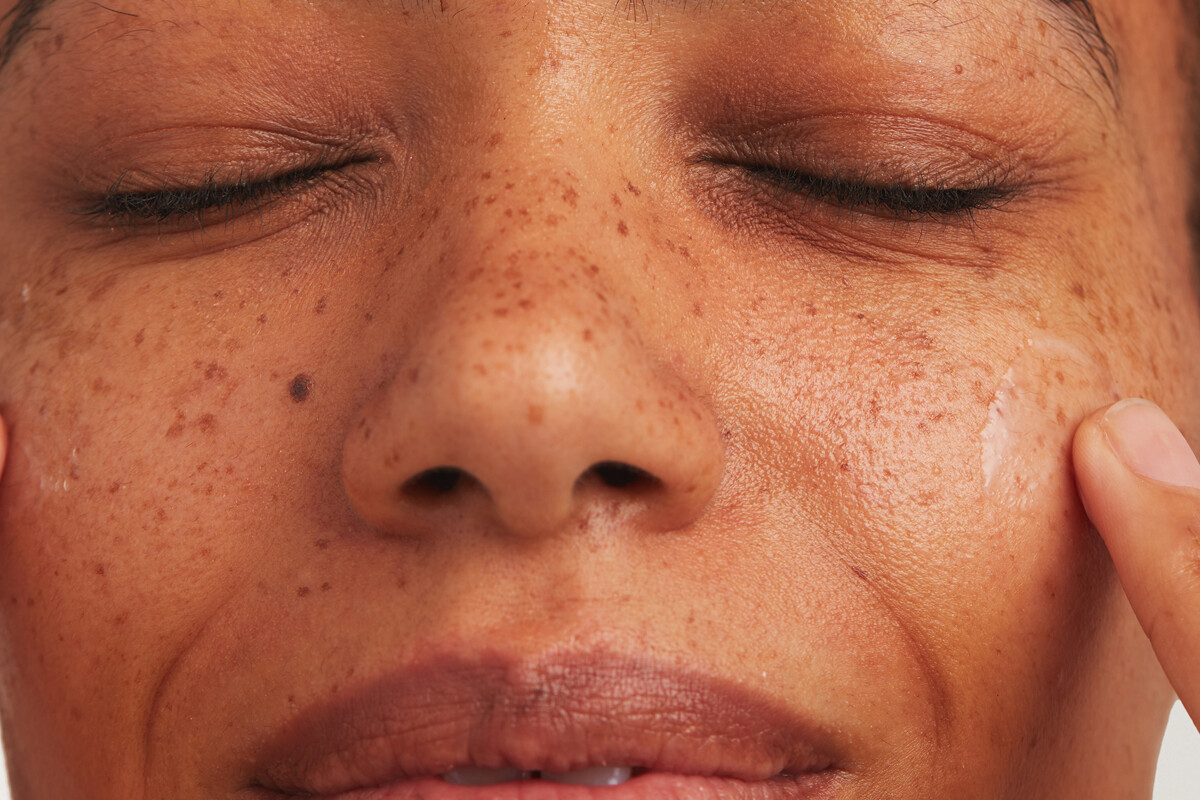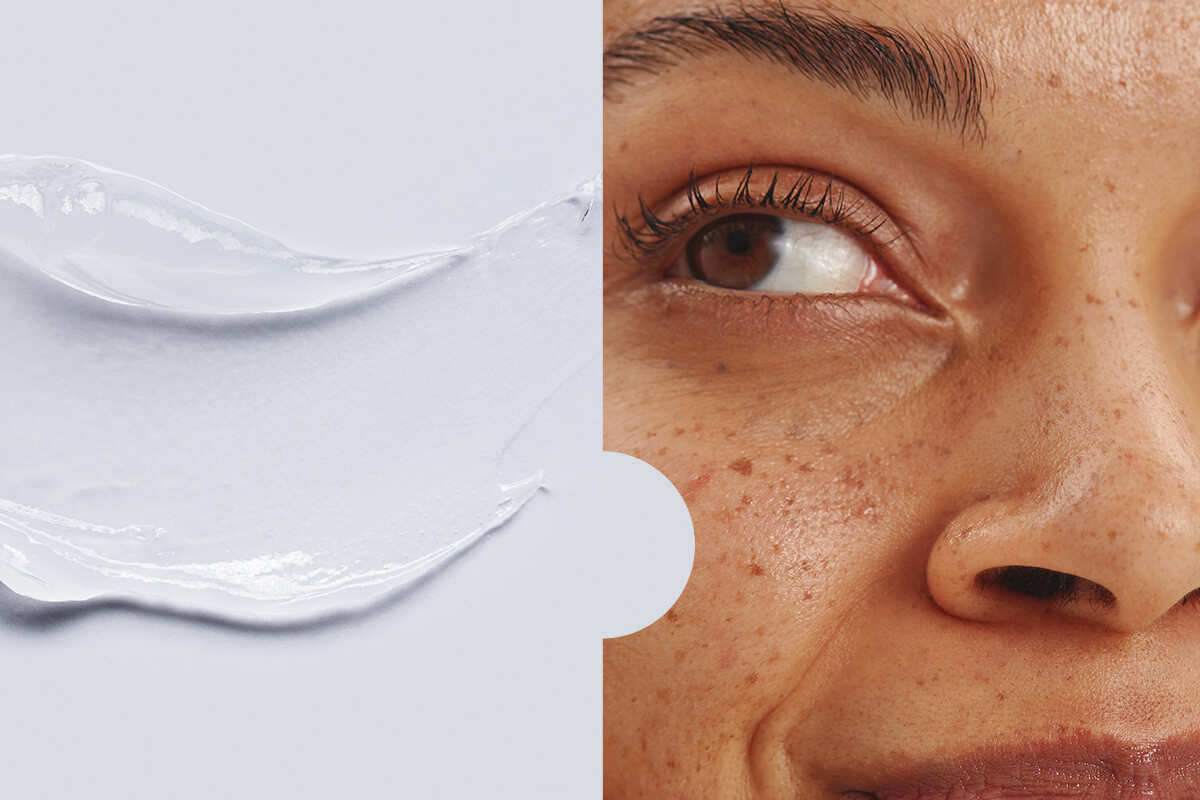Is tranexamic acid suddenly on your radar?
This synthetic derivative of lysine is used in many medical settings to control bleeding. But what exactly can it do as a treatment for hyperpigmentation?
Is It Good For Your Skin?
Studies show tranexamic acid (TXA) has a wide variety of skin benefits. It’s often found in serums, creams, and masks that are available over the counter. It’s sometimes combined with other active ingredients to boost its effects.
Tranexamic acid can also be taken orally for more severe cases of hyperpigmentation, but this should always be done under the guidance of a healthcare professional. (1)
Benefits
A Treatment For Melasma, Dark Spots & Post-Acne Marks
Tranexamic acid effectively reduces visible hyperpigmentation, including melasma, dark spots, and post-inflammatory hyperpigmentation (PIH) caused by acne. One of the ways in which it is believed to work is by reducing melanin synthesis.
Safe For Most Skin Types
Tranexamic acid is generally compatible with all skin types, including sensitive skin. It can be used alongside other ingredients like niacinamide, hyaluronic acid, retinoids and Vitamin C.
Enhances Natural Skin Glow
Reducing the production of melanin helps brighten and even out the overall skin tone. (2)
What Percentage Of Tranexamic Acid Is Good For Skin?
In skincare formulations, we typically see tranexamic acid serums in concentrations ranging from 2% to 5%. Here’s a breakdown of what these concentrations can offer:
– 2%: This is a common concentration found in many over-the-counter skincare products. It’s effective at fading mild hyperpigmentation, improving skin tone, and generally brightening your complexion. It’s usually well-tolerated by most skin types, including sensitive skin.
– 3% to 5%: These concentrations are often found in more potent treatments used for addressing more severe pigmentation issues like melasma and stubborn dark spots. Products with these concentrations may offer faster and more noticeable results but can also be harsher on the skin, so it’s important to monitor skin irritation and adjust usage if any reactions occur.
It’s important to start with lower concentrations of tranexamic acid serum if you have sensitive skin, or if you’re new to this ingredient. Incorporating it into your routine gradually can help your skin adjust gradually, reducing the risk of irritation.
Additionally, combining tranexamic acid with other complementary ingredients like niacinamide, hyaluronic acid, or Vitamin C can enhance how effective it is and provide even more benefits. We discuss this more in the sections below. (3)
How Long Does It Take To Work?
The time it takes to see visible results on the skin from tranexamic acid can depend on many different factors, including the severity of hyperpigmentation, how concentrated the product is, the ingredients it’s combined with, your individual skin type and how it responds to the ingredient. Generally, here’s a timeline of what you most people can expect:
Initial Improvement (2-4 weeks)
Some people may start noticing initial improvements in skin tone and brightness within the first few weeks of consistent use. Minor dark spots and overall skin radiance could begin to show signs of improvement.
Moderate Improvement (4-8 weeks)
You may see more noticeable changes in hyperpigmentation, including a reduction in the intensity of dark spots and melasma. Your skin tone may look more even, and pigmentation continues to fade.
Significant Improvement (8-12 weeks and beyond)
For more stubborn types of skin discolorations, visible improvements can take 8 to 12 weeks or longer. The more consistently you use it, the more the hyperpigmentation will fade in appearance.
It’s important to note that individual results can vary, and patience is key when using any skincare treatment for hyperpigmentation. Consistency in applying the product as directed is crucial for achieving the best results. Additionally, combining tranexamic acid with other skincare ingredients like niacinamide or vitamin C, and protecting the skin from sun exposure with a broad-spectrum sunscreen, can enhance the effectiveness of the treatment.
If you don’t see any improvement after several months of consistent use, it might be helpful to consult with a dermatology professional for personalised advice and potential alternative treatments. (2)
Can You Use It Every Day?
Yes, tranexamic acid can be used on the skin every day. In fact daily use is what’s typically recommended for the best results. Here are some tips for using tranexamic acid in your skincare routine.
1. Start Slowly: Use it every other day at first to see how your skin reacts. If there is no irritation, you can gradually increase this to daily use.
2. Check The Concentration: Over-the-counter products usually contain concentrations ranging from 2% to 5%, which are generally safe for daily use. Always read the specific instructions provided by the product, to be sure.
3. Application: Tranexamic acid can be applied once or twice daily, depending on the formulation and your skin’s tolerance. We recommend using it only once a day, especially if there are other active ingredients in your routine. It’s typically applied after cleansing and toning but before moisturising.
4. Complementary Products: You can use tranexamic acid alongside other active ingredients like niacinamide, hyaluronic acid, and Vitamin C. These combinations can enhance the overall effectiveness of your skincare routine.
5. Sun Protection: It’s so important to use sunscreen during the day when using tranexamic acid, as it helps prevent further hyperpigmentation and protects your skin from UV damage.
6. Keep Checking Back: If you experience any signs of irritation, such as redness, dryness or stinging, reduce how often you apply it or try a lower concentration.
Always perform a patch test before bringing any new product into your regular rotation to avoid adverse reactions. If you have sensitive skin or any pre-existing skin conditions, ask a dermatology professional like the experts at Dermatica before starting tranexamic acid or any new skincare product.
Side Effects
Most people can generally use skincare products with tranexamic acid without any issues, but a small few might notice an adverse reaction. These side effects include:
Mild Irritation
Mild irritation, such as redness, itching, or a slight burning sensation is common, particularly when you first start using tranexamic acid, or if you’re starting a higher concentration.
Dryness
Tranexamic acid can sometimes cause dryness or flakiness, especially if you have sensitive skin or if you use it in combination with other potentially drying ingredients.
Allergic Reactions
It’s rare, however some individuals might experience allergic reactions like redness, swelling, or itching. If you do, it’s important to stop using it and talk to a dermatology expert or your doctor about your symptoms.
How To Minimise The Risk Of Side Effects
Patch Test
Always do a patch test before applying tranexamic acid to your whole face. Apply a small amount to your wrist or behind your ear, and wait 24-48 hours to see if any reaction occurs.
Moisturise
Use a nourishing moisturiser to counteract any dryness or irritation.
Avoid Harsh Combinations
Be cautious when combining tranexamic acid with other potent active ingredients like retinoids or strong exfoliants, as you might irritate your skin.
If you notice severe irritation, or damage to your skin barrier, stop using it and ask a dermatology expert to tailor a skincare routine to soothe your skin and restore it to a natural, balanced state. (4)
Is Tranexamic Acid A Retinol?
No, tranexamic acid is not a retinol. They are different ingredients with distinctive properties and functions in skincare.
Tranexamic Acid focuses on reducing hyperpigmentation and brightening the skin, while retinol targets premature skin ageing concerns like fine lines, wrinkles, and uneven skin texture.
Tranexamic acid inhibits pathways involved in pigmentation, whereas retinol speeds up skin cell turnover and boosts collagen production.
Tranexamic acid is generally milder than retinol or retinoids, and less likely to cause side effects.
Uses in Skincare
Tranexamic Acid mainly targets hyperpigmentation issues, including melasma and dark spots. You can use it in the morning (make sure you wear sunscreen after) and generally works for all skin types.
Retinol is usually recommended for anti-ageing or acne routines. It should be introduced gradually to let your skin build up tolerance slowly. Night-time application is better since this ingredient is sensitive to sunlight.
Both ingredients can be beneficial, and can be used together to address different skin concerns. Ask a dermatology expert for advice to make sure your routine suits your specific skin needs.
Can Tranexamic Acid And Retinol Be Used Together?
Combining these ingredients can be an effective combination, but it’s important to introduce them carefully to avoid potential side effects like irritation.
As they’re both active ingredients, try using them at different times of day to reduce the possibility for irritation or side effects. We always recommend using your retinoid in the evening after cleansing, so it’s a good idea to reserve your tranexamic acid product for your morning routine (after cleansing and before sunscreen).
If you want to use these topical treatments alongside each other, start with lower concentrations and do a patch test. If you have specific concerns or particularly sensitive skin, always talk to your dermatology expert for advice. (5)
Is Tranexamic Acid Better Than Vitamin C?
Tranexamic acid and Vitamin C are both effective ingredients for treating hyperpigmentation. They work in different ways, and are both beneficial. One isn’t better than the other for fading dark spots.
Tranexamic acid is more targeted toward reducing hyperpigmentation, while Vitamin C is better suited for general skin health and reducing all visible signs of ageing. Most people will benefit from using both, because each one targets different aspects of skin care.
If you’re not sure if this combination is right for you, ask your dermatology expert to help you create a personalised routine that suits your individual needs and goals. (6)
Products We Recommend For Hyperpigmentation
SPF50 Photodamage Defence Sunscreen
Sun exposure causes 90% of visible skin ageing, and darkens hyperpigmentation. Always use broad-spectrum sunscreen during the day to prevent your sun damage and pigmentation from getting worse.
Vitamin C 15%: Fresh Batch Ascorbic Acid
Formulated with a science-backed powerhouse of L-ascorbic acid (the most potent form of topical Vitamin C), Vitamin E and ferulic acid, this booster is designed to keep the photosensitive ingredients potent for as long as possible. To bring you maximum benefits with every last drop.
Personalised Treatment Plan For Hyperpigmentation
For the best results, Dermatica offers a personalised service where our real dermatology experts help design a hyperpigmentation treatment plan based on your skin and your goals.
Your unique formula will include ingredients you can’t get over the counter, which are up to 20x more potent than shop-bought skincare. Find out what formulas are suitable for your skin by visiting our website.
References
1. Batra J, Brar B, Kumar S, Arora H. Tranexamic acid in melasma: Comparative evaluation of therapeutic efficacy of oral tranexamic acid versus its transepidermal administration. Journal of Cutaneous and Aesthetic Surgery. 2022;15(4):394.
2. Gaćina, K. (2023). The Use of Tranexamic Acid in Dermatology. Acta Clinica Croatica. doi: https://doi.org/10.20471/acc.2023.62.02.16.
3. Ebrahimi, B. and Naeini, F.F. (2014). Topical tranexamic acid as a promising treatment for melasma. Journal of Research in Medical Sciences: The Official Journal of Isfahan University of Medical Sciences, [online] 19(8), pp.753–757. Available at: https://www.ncbi.nlm.nih.gov/pmc/articles/PMC4235096/.
4. Kamal, S., Doaa Salah Hegab, El, M. and Ashmawy, A.A. (2023). Efficacy and Safety of Topical Tranexamic Acid Alone or in Combination with Either Fractional Carbon Dioxide Laser or Microneedling for the Treatment of Melasma. Dermatology practical & conceptual, [online] pp.e2023195–e2023195. doi: https://doi.org/10.5826/dpc.1303a195.
5. González-Molina, V., Martí-Pineda, A. and González, N. (2022). Topical Treatments for Melasma and Their Mechanism of Action. The Journal of Clinical and Aesthetic Dermatology, [online] 15(5), pp.19–28. Available at: https://www.ncbi.nlm.nih.gov/pmc/articles/PMC9122278/.
6. Kaikati, J., El Bcherawi, N., Khater, J.A., Dib, S.M., Kechichian, E. and Helou, J. (2023). Combination Topical Tranexamic Acid and Vitamin C for the Treatment of Refractory Melasma. The Journal of clinical and aesthetic dermatology, [online] 16(7), pp.63–65. Available at: https://www.ncbi.nlm.nih.gov/pmc/articles/PMC10409511/
Cat Hyatt
Dr Cat Hyatt is a GP, working as Clinical Content Lead for Dermatica. She has a special interest in medical content and making healthcare information accessible and understandable for all.





